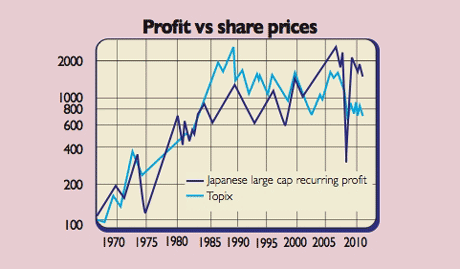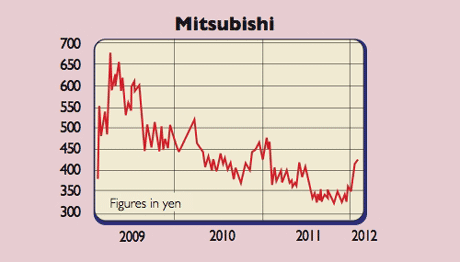Why Japanese stocks are set to soar
After two decades of economic malaise, Japanese stocks are about to take off, says James Ferguson. Here's how to profit.
On 25 November last year, the Tokyo First Section (Japan's Topix index) opened at 704, only a shade above its March 2009 closing low of 701. Before that, the last time the Japanese stockmarket had been so low was in December 1983.
Since last November, however, Japanese stocks haven't looked back. They've risen by almost 19%, with the vast majority of that move occurring over the last five weeks. Chartists may not have noticed the three-year double-bottom a powerful base formation pattern because everyone gave up looking at the Japanese stockmarket (except for reasons of schadenfreude) a long time ago. But that could be a big mistake.
Last July, I wrote a piece for MoneyWeek pointing out just how cheap Japanese stocks were, and how that put a strong downside floor under the index a floor that held bang on demand on 25 November. The Topix index now yields more than the S&P 500. Japanese stocks trade at book value American stocks are more than twice as pricey on 2.2 times.
MoneyWeek
Subscribe to MoneyWeek today and get your first six magazine issues absolutely FREE

Sign up to Money Morning
Don't miss the latest investment and personal finances news, market analysis, plus money-saving tips with our free twice-daily newsletter
Don't miss the latest investment and personal finances news, market analysis, plus money-saving tips with our free twice-daily newsletter

Where Japan doesn't look cheap, however, is on earnings. Two decades of economic malaise have made it very hard for Japanese companies to generate profits. To turn the potential of a really cheap valuation story into an actual humdinger of a market, that needs to change. Two momentous shifts in the last month could well be the catalyst.
The truth about the lost decades
People talk about Japan's lousy demographics and the rising dependency ratio (the ratio of old retirees to the young people supporting them). But China and Germany arguably look even worse on this basis. The true problem is that the Japanese economy has been beset for the last two decades by twin evils.
The first is a remorselessly strong yen. This robs the country's household-name exporters, such as Toyota, Canon and Sony, of any chance of making a decent profit. On the upside, this has forged a commitment to quality and cost control that is second to none.
The other drag on Japan afflicts the much larger domestic sector, which, because of its early 1990s bank crisis, is about to enter its third decade of deflationary credit contraction. This has meant anaemic money-supply growth, zero nominal GDP growth, a stockmarket back where it was in 1983, and commercial real-estate prices that are back at the same level they were in 1970. Both of these drags look as though they are about to reverse, with potentially explosive results.
The rise and rise of the yen
Japan's exporters have had to contend with a currency that has risen by about 30% each decade for the last 40 years. Over the last decade alone, the yen has gained another 40% on the US dollar. That's about 3.5% a year. It's the main reason why a firm such as Sony, for example, has only managed an average operating profit margin of around 1.5% since 2002.
To give you an idea of just how debilitating this currency water torture has been, you just need to look at the brief periods of respite. Between 1995 and 1998, the yen experienced a rare bout of weakness, falling from an average for the year of around 97 to the dollar to about 128. That (roughly) 25% decline in the currency sent Sony's operating profit margin from -4.2% to 7.7%, a turnaround of almost 12 percentage points.
In short, give Japanese exporters a break from the relentless and grinding currency appreciation, and the impact on profits would be spectacular. This is all very pertinent, since the yen has dropped 6% against the greenback this month alone.
Given that the yen was hitting record highs as recently as November, is there any reason to think the recent weakness is anything more than trading volatility? As it turns out, there are plenty of reasons. For starters, since the tsunami last March, which shut down a lot of Japan's nuclear facilities and forced oil imports up in their stead, the country has been running an almost-unheard-of trade deficit. This means the current-account surplus (Japan still repatriates net foreign earnings when the capital account is included) has fallen from almost 5% of GDP in 2007, to a near 15-year low of 2.1%.
In fact, that last significant period of yen weakness from 1995 to 1998 coincided with the current account surplus falling as low as 1.4% of GDP and averaging 2.1%. Given that movements in the current account lead the currency by several months, this suggests the outlook for the yen is weak a situation that would be potentially explosive for exporters' earnings.
Japan helped by strong dollar
But it's not just about yen weakness it's also about US dollar strength. After five years of interest-rate cuts followed by quantitative easing (QE), US bank lending is finally rising again. This doesn't mean that Federal Reserve chairman Ben Bernanke won't do QE for a third time.
But it does mean that technically there is no need to do any more. QE is how a central bank artificially boosts broad money supply to counteract the destruction of money that happens when banks rein in lending. Once lending is expanding again, money is no longer being destroyed and no QE is needed. Without QE diluting the currency, the downward pressure on the dollar that has persisted for the last five years will cease.
There's another reason why the American dollar could strengthen markedly this year. About half of the US's trade deficit is comprised of energy imports. Recent advances in horizontal drilling and hydraulic fracturing (fracking') are releasing a huge amount of shale oil and gas.
Indeed, recent estimates suggest that America is sitting on shale gas supplies that are equivalent to 40 years of current gas consumption. Partly as a result, America's natural gas Henry Hub spot price has halved since June.
There are environmental concerns over shale, and estimates of the reserves may have been overhyped. But even taking this into account, increasingly cheap and plentiful gas now looks assured, meaning that the US can increasingly wean itself off imported oil. Gas is a substitute for other feedstock fuels, such as oil and coal, particularly in electricity generation, but also in transport.
The trouble for the rest of the world is that, because the dollar is the reserve currency, we need America to run a decent-sized current-account deficit or there won't be enough excess' dollars washing around to fund global trade. A shortage, brought about by a smaller US reliance on imported oil, will bid the price of remaining dollars up, potentially quite significantly.
The Bank of Japan wakes up
As if all that wasn't enough, just two weeks ago, the Bank of Japan (BoJ) signalled a sea change in its monetary policy. After a mere two decades of fiddling, the central bank has finally set an inflation target (of 1% "for the time being"), and it has embarked on QE as its means of getting there.
This may sound strange coming from the country that effectively invented the term "quantitative easing", but it's important to realise that Japan's QE was nothing like the American or British versions of QE.
Japan's QE has largely consisted of buying short-dated Japanese Government Bonds (JGB) in traditional money-market operations with the banks. This boosted bank reserves, just as similar early crisis activities did in the Anglo-Saxon economies. However, BoJ Governor Shirakawa stopped there, and was still left with an undercapitalised banking system that was unable or unwilling to pass easier credit conditions on to the wider economy.
In the West, we instead did something quite radical. Our version of QE involves circumventing the recalcitrant banks altogether and requires the central bank to take the "unconventional" route. This means the central banks buy long-dated securities from non-banks (so-called debt market operations).
The counter party is all important in this situation, because the non-bank seller (a pension fund, say) deposits the proceeds of the trade in their bank account. This swells bank deposit liabilities or money supply, as we mere mortals call it. In other words, it's genuinely adding money into the system, rather than just directly swapping the government bonds on a bank's balance sheet for cash, which doesn't.
Shirokawa has always resisted this strategy because as an unelected bureaucrat he has argued that it is not his job to carry out what amounts to a redistributive fiscal policy and a regressive one at that. This is central-banker speak for: QE may inflate the economy, but it takes money from the poor and gives it to the rich.
He's absolutely right in this assessment. However, the Japanese Diet has recently given him a very hard time, which he has obviously interpreted as an instruction from elected officials to proceed to Western-style QE.
The relatively new Asset Purchase Program (APP) has already reached 55trn (about 12% of GDP), but until October it was still limiting itself to bonds of less than a two-year maturity. Only the most recent 10trn (roughly 2% of GDP) appears to be targeted at properly long-term bonds and this is vital.
Why? Because QE only has an inflationary impact on money supply, and a dilutive effect on the currency, if the seller is a non-bank. To get Japanese consumer price index (CPI) inflation up to an annual rate of +1% from its present -0.2% level, Japan will probably have to do QE equivalent to about 15% of GDP but the first wave has already sent the yen down 6%.
The return of Japanese property
While a weak yen would give Japan's export sector an almost unprecedented earnings boom, the vast majority of the country is oppressed by another problem altogether a banking system that just will not function. Importantly, as we have seen since 2009, Western-style QE doesn't just boost CPI, it has a dramatic impact on asset prices, especially stocks.
A Bank of England working paper estimates that stock prices probably went up by 20% as a direct response to the first £200bn of QE in Britain, for example. In turn, rising stock prices boost wealth, consumer confidence and the net asset values of companies' cross-holdings of shares. Banking loan covenants also improve richer firms are less likely to default.
However, it is the relationship between bank lending and property values that is core to both Japan's problems and its eventual prosperity. According to Japanese government data, commercial land prices in Japan's largest six cities have fallen by 86% since the 1991 peak, and are now back at 1977 levels. National commercial land prices are back where they were in 1970. The collapse has been catastrophic.
But it hasn't all been one-way. Between the first quarter of 2005 and the first quarter of 2008 (off a low base), nationwide commercial land prices rallied by 50%. They're pretty much back down where they started again now. But crucially, this rally occurred at exactly the same time as (and was entirely due to) the only increase since the early 1990s in Japanese bank borrowing. Borrowing grew by just over 8% between June 2005 and the end of 2008.
Excitingly, bank lending is picking up again now, because the BoJ has been boosting bank reserves again. This time (unlike in the early 2000s), Japanese banks no longer need to focus on repairing their balance sheets. Bank lending is only 1.2% higher than it was back in June, but most of that move has occurred in the last two months. If this gains traction, land prices have huge upside. They could double and still only be back at their 1981 price.
Key to this is what bank lending could do, but again, the upside is fantastic. European banks are having to be force-fed European Central Bank emergency funding (via LTRO, the European version of QE) because their loan books are too big to be fully funded by customer deposits.
Japanese banks are in the exact opposite position. The loan book of Mitsubishi UFJ (MUFJ), Japan's biggest bank, is only 60% the size of its customer deposits. To return to a normal long-run position, where deposits and loans are roughly equal, European banks would have to shrink loan assets by several trillions of euros.
MUFJ, on the other hand, needs to expand lending by two-thirds. The economy-wide expansion of bank lending that sent commercial land prices up by almost 50% from 2005 to 2008, and the stockmarket up by an even larger amount, totalled 33trn. The gap between MUFJ's deposits and its loans is 54trn; and that's just one bank.
Japanese stocks look cheap

As the chart above shows, if we re-base Japanese large and mid-cap companies' earnings to the main Topix index all the way back to the 1960s (so we're comparing earnings directly with stock prices), we can see that the market was largely at fair value right up until 1985, when share prices took off to an unjustifiable degree.
It took until the post-dotcom fallout for the index finally to drop below a level justified by earnings, and indeed from the 2003 low, the Topix rose 130% in three years. This latest sell-off, however, has finally induced total investor revulsion, much as we saw in the British and US markets at the 1982 lows. Compared to underlying earnings, the Topix is now as oversold as it was previously overbought at the top of the bubble back in 1990.
What Japan seems to represent here is an extreme but positive tail risk, which, because of the solid floor of support at 700 on the Topix, also comes with an extremely asymmetric risk profile. In other words, your downside looks very limited, but there is a chance of almost historic upside potential if the gears keep aligning themselves in Japan's favour.
The great frustration for many outside observers of Japan has long been that many of the country's most insidious problems were fairly easily and swiftly correctable, if only the largely octogenarian plutocracy running the country would turn their minds to it. Thankfully, and largely because of the perceived success of similar strategies by Western governments, they are finally giving it a go. We look at how to profit below. Hold onto your hats!
Don't hedge your exposure to the yen
An important consideration for sterling investors in Japan is whether or not to hedge exposure to the yen. Usually with Japan, what you win with the currency, you lose with the market, and vice versa. If the yen strengthens, as has been typical for most of the last 20 years, the value in sterling of any Japanese market exposure goes up, but unfortunately this is more than outweighed by the negative impact on stockmarket earnings.
For exporting manufacturers, as illustrated by the Sony example, double-digit percentage changes in the currency lead to large single-digit changes in operating margins, which can translate into multiple moves in actual reported profits.
On the other hand, the domestic sectors, which should by rights be benefiting in a strong yen environment from easier monetary policy and lower rates, haven't done so for the last few years because of a banking system struggling until now to emerge from its earlier crisis.
As we have learned to our cost since 2007 here in Britain, banks repairing their balance sheets after a crisis are loath to pass on the benefits of a low rates policy to actual borrowers in the real economy, either in terms of actual loans or in the form of cheap credit.
Japan's Topix seems to have put in a solid floor at 700 and the Bank of Japan's new policy of Western-style QE appears both to be weakening the yen and, as we've seen in the West, should boost risk asset prices, especially stocks.
Hedging exposure to the yen in these circumstances actually increases your risk, rather than mitigating it. The hedge pays out on a weakening yen, but this will also drive stocks higher. So sterling investors shouldn't hedge their currency exposure, because if it does turn out that the BoJ reneges on its plan to boost inflation, or simply loses its nerve with QE, at least market downside should be limited to 700 while a stronger yen should temper losses to a certain degree too.
How to invest in Japan's recovery
The best way to play yen weakness is through Sony (JP: 6758) because that's the big-name manufacturer with the consistently lowest operating margins (and hence the biggest gearing to the currency). Toyota (JP: 7203), Honda (JP: 7267), Canon (JP: 7751) and MEI (JP: 6752), which markets its products under the Panasonic brand in Britain, are also worth a look.
Of these, Toyota is the one that has come under the cosh the most over the last three years, with recent operating margins averaging less than 1%, compared to 8%-plus during the earlier part of the decade. Again, this is a company with real operational gearing to a weaker yen as it recovers.
The core two plays on the domestic-sector side are the banking giant MUFJ (JP: 8306) and the other side of that story, the blue-chip real-estate stock, Mitsubishi Estate (JP: 8802), which owns the vast bulk of the prime downtown Tokyo business district office market. Mitsubishi Estate's share price surged by more than 500% between its 2003 lows and the 2007 peak. Today it languishes at just a third of that 2007 high, though it has already started to move, up nearly 30% since mid-January.

Another story that Japan stands at the forefront of, and that we didn't have the space to cover here, is robotics. One of MEI's flat panel TV manufacturing sites has seen its workforce drop from almost 5,000 to just 15 highly skilled engineers, after it fully automated the plant.
Automated technology that was developed as far back as the 1980s has finally reached the sort of mass production critical mass that brings prices down to competitive levels. The next manufacturing revolution will be cheap robots, not the cheap labour story that has buoyed China through the last decade.
Japan's top play in manufacturing robotics is a firm called Fanuc (JP: 6954). It's trading today at the same price that it did at the turn of the century, even though operating profit margins were some 40% higher last year than they were back then.
Any Japan funds should be lifted by the rising tide. But the most attractive is probably the Morant Wright Japan Fund, a value specialist concentrating on small caps with strong balance sheets and yielding more than the market at 2.8%.
While the market trades around book value, the Morant Wright Fund trades on just 0.6 times book, and one of the fund managers tells me that six of their holdings trade for less than the net cash on the balance sheet. How's that for value?
Other Japan funds that we like include the Baillie Gifford Shin Nippon investment trust (LSE: BGS). (Full disclosure, Merryn Somerset Webb, MoneyWeek's editor-in-chief, is now a non-executive director on the board of this trust, and invests in it.) It trades at a discount to net asset value of around 10%, and focuses on smaller companies. Another investment trust option is the JP Morgan Japanese investment trust (LSE: JFJ), trading on a discount of around 14%.
As we've noted before, if you like Japan but don't want to go all in', the Ruffer Total Return Fund (a unit trust with a total expense ratio of 1.52%) is worth considering. Co-managed by MoneyWeek roundtable regular Steve Russell and David Ballance, it holds 17% of its money in Japanese equities, with the rest accounted for by a mix of asset classes we generally like too, including index-linked bonds, gold and gold mining stocks.
This article was originally published in MoneyWeek magazine issue number 578 on 2 March 2012, and was available exclusively to magazine subscribers. To read all our subscriber-only articles right away, subscribe to MoneyWeek magazine.
Get the latest financial news, insights and expert analysis from our award-winning MoneyWeek team, to help you understand what really matters when it comes to your finances.
James Ferguson qualified with an MA (Hons) in economics from Edinburgh University in 1985. For the last 21 years he has had a high-powered career in institutional stock broking, specialising in equities, working for Nomura, Robert Fleming, SBC Warburg, Dresdner Kleinwort Wasserstein and Mitsubishi Securities.
-
 The best and worst performing UK stocks of 2025 as FTSE 100 approaches record year
The best and worst performing UK stocks of 2025 as FTSE 100 approaches record yearThe blue-chip index is heading for another top year despite investors steering clear of UK equity funds
-
 Which sectors are best to invest in for 2026?
Which sectors are best to invest in for 2026?Investment trust portfolio managers give their views on the sectors and regions they expect to outperform in 2026.